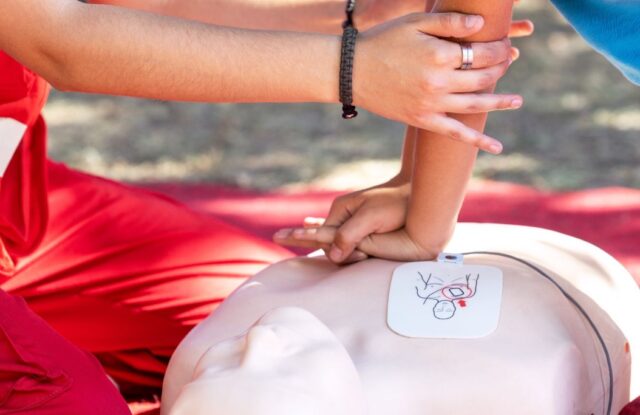Cardiopulmonary resuscitation (CPR) can mean the difference between life and death in an emergency. However, mistakes during CPR can lead to ineffective efforts, reducing the chances of survival.
Awareness of these mistakes and how to avoid them is essential for providing effective care.
Key Points:
- Incomplete chest compressions reduce effectiveness.
- Incorrect hand placement can cause injury.
- Not enough pressure limits blood flow.
- Too slow or fast compressions disrupt rhythm.
- Forgetting to check the airway may block airflow.
- Stopping too soon can lead to poor outcomes.
Mistake 1 ─ Incomplete Chest Compressions
One of the most common mistakes involves shallow compressions. Effective CPR requires deep and consistent compressions to circulate blood. Many fail to push hard enough, often due to fear of causing injury. However, the priority is saving a life, and compressions must reach the required depth to be effective.
To avoid this mistake, ensure compressions are deep enough. Aim for at least two inches of depth for adults. Maintain this pressure throughout the procedure.
For more detailed guidance, consider checking out certifications from MyCPR NOW. They offer comprehensive resources and materials. Their certifications and course materials equip you with the skills needed to handle emergencies. With an online class, you will be ready to react swiftly and effectively, helping save a life until professional help arrives.

Mistake 2 ─ Incorrect Hand Placement
Placing hands too high or too low on the chest can cause broken ribs or fail to generate enough pressure. Correct hand placement is critical to ensure efficient compressions.
To place hands correctly, position them on the lower half of the breastbone. Avoid moving too far toward the abdomen or the upper chest. Correct hand placement will direct the force where it’s most needed, minimizing the risk of fractures and enhancing blood flow.
Mistake 3 ─ Not Applying Enough Pressure
Many people hesitate to apply sufficient force during compressions, fearing they will hurt the person. However, without enough pressure, CPR becomes ineffective. Proper compressions require considerable strength to ensure blood flow to the brain and other organs.
To apply enough pressure, use your body weight rather than just your arms. Lean forward and press firmly into the chest, maintaining the necessary depth of two inches.
Mistake 4 ─ Compressions at the Wrong Speed
Performing compressions too quickly or too slowly disrupts the rhythm necessary for effective CPR. Speed plays a significant role in maintaining blood circulation.
To keep the right speed, aim for a rate of 100 to 120 compressions per minute. Staying within this range helps maintain an optimal rhythm that supports blood flow without overwhelming the heart.
Mistake 5 ─ Forgetting to Check the Airway
Ignoring the airway during CPR can render efforts useless. Blocked airways prevent oxygen from reaching the lungs, no matter how effective chest compressions are.
Before starting CPR, always check the airway. Make sure nothing is blocking it and tilt the person’s head back to open the airway. This allows for proper oxygen flow, giving the person a better chance of recovery.
Mistake 6 ─ Giving Too Many or Too Few Rescue Breaths
Rescue breaths are an essential part of CPR, but giving too many or too few can reduce effectiveness. It is important to give two rescue breaths after every 30 chest compressions.
To avoid errors, ensure you give only two breaths. Each breath should last about one second and cause a visible chest rise. This ensures that enough oxygen reaches the lungs without overwhelming them.
Mistake 7 ─ Stopping CPR Too Early
Many stop CPR too soon, either due to fatigue or the assumption that help will arrive. However, CPR must continue until professional help arrives or the person shows signs of life.
Even if you feel tired, it’s essential to keep going. If possible, have someone else take over if you cannot continue. Every second counts, and stopping early can reduce the chances of survival.

Mistake 8 ─ Poor Body Positioning
Incorrect body posture can affect the quality of compressions. Leaning too far back or bending too much reduces the force applied to the chest.
To ensure effective compressions, kneel directly beside the person and lean over them. Use your body weight to apply force and maintain a straight posture. This helps prevent strain and ensures compressions are consistent.
Mistake 9 ─ Not Asking for Help
Failing to call for help immediately can delay professional intervention. CPR alone is not enough to save a life; medical professionals need to take over as soon as possible.
Always call for emergency services before starting CPR. If someone is nearby, ask them to call while you perform CPR. Time is critical, and immediate help can make a huge difference in survival.
Avoiding Mistakes Increases Survival Rates
Effective CPR can double or triple the survival rates in cardiac arrest cases. However, avoiding common mistakes is crucial to ensuring CPR provides the best chance of success.
Proper training, attention to technique, and maintaining the right rhythm can all increase the chances of saving a life. If you’re unsure about your CPR skills, seek out training to improve your knowledge and performance. It’s not just about knowing what to do; it’s about doing it right when it matters most.




